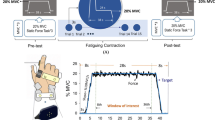Abstract
We examined motor unit (MU) discharge properties (mean interspike interval, ISI, discharge variability, short-term synchronization, common drive) and force tremor in the first dorsal interosseous (FDI) muscle of five musicians (skill-trained), five weight-lifters (strength-trained) and six untrained subjects during low-force isometric abduction of the index finger. Mean MU ISI was slightly shorter in skill-trained subjects than in untrained subjects. Discharge variability of FDI MUs did not differ significantly between groups. The mean strength of MU synchronization (expressed as the frequency of extra synchronous discharges above chance) was different in skill-trained (0.22±0.02 s–1, 162 MU pairs), untrained (0.32±0.02 s–1, 199 MU pairs) and strength-trained subjects (0.44±0.03 s–1, 183 MU pairs). FDI MU synchrony was weak and of equivalent strength in both hands of skill-trained subjects and the dominant (skilled) hand of untrained subjects. The stronger FDI MU synchrony in the non-dominant hand of untrained subjects was equivalent to that found in both hands of strength-trained subjects. The extent of common modulation of firing rates (common drive) was assessed for a subset of MU pairs and was weaker in skill-trained subjects (0.30±0.04, n=14) than untrained (0.43±0.3, n=14) and strength-trained (0.48±0.03, n=21) subjects. Force tremor was quantified for each hand in the same subjects during isometric index finger abduction at target forces of 0.5 N and 3.5 N. Tremor rms amplitude and peak power in the force frequency spectrum were significantly lower in skill-trained subjects than strength-trained subjects with the 3.5-N target force. The peak tremor frequency was similar in the three groups. The relatively more independent discharge of pairs of FDI MUs in skill-trained subjects was not responsible for the reduced tremor amplitudes in these subjects. Correlations between the overall extent of MU synchrony and common drive in FDI muscles and tremor measures obtained during the same experimental session were all non-significant. Differences in the central descending command signals are the most likely explanation for the more independent discharge of FDI MUs in skill-trained hands, while neural or peripheral muscular factors may be responsible for the weaker tremor.
Similar content being viewed by others
Author information
Authors and Affiliations
Additional information
Received: 15 May 1997 / Accepted: 15 August 1997
Rights and permissions
About this article
Cite this article
Semmler, J., Nordstrom, M. Motor unit discharge and force tremor in skill- and strength-trained individuals. Exp Brain Res 119, 27–38 (1998). https://doi.org/10.1007/s002210050316
Issue Date:
DOI: https://doi.org/10.1007/s002210050316




